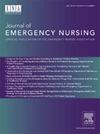超越护士效率:对分诊时间中护士、环境和患者相关因素的多层次分析。
IF 2.3
4区 医学
Q2 EMERGENCY MEDICINE
引用次数: 0
摘要
前言:本研究旨在探讨影响急诊科分诊时间的因素,比较个体护士特征与环境和患者相关变量的影响。方法:这项单中心回顾性观察设计于2016年1月1日至2022年12月31日进行,分析了梅拉诺医院382,027例分诊事件。排除受2019冠状病毒病大流行影响时期的数据,以确保在标准紧急条件下进行分析。使用统计模型评估分诊持续时间,包括随机效应,以捕获个体和系统影响。结果:51名护士进行分诊,中位时间1.9分钟(四分位数差1.1 ~ 3.7)。护士相关因素仅占变异的11.5%,而患者和环境因素的影响更大。老年患者分诊时间较长(+0.0079 min/y;讨论:分诊模式应纳入更广泛的环境和患者相关因素,而不是主要关注护士效率。需要进一步的研究来全面确定分诊性能的决定因素,以优化急诊护理的速度和质量。本文章由计算机程序翻译,如有差异,请以英文原文为准。
Beyond Nurse Efficiency: A Multilevel Analysis of Nurse, Contextual, and Patient-Related Factors in Triage Duration
Introduction
This study aimed to investigate the factors influencing triage duration in emergency departments, comparing the impact of individual nurse characteristics with contextual and patient-related variables.
Methods
This monocentric retrospective observational design, conducted from January 1, 2016, to December 31, 2022, analyzed 382,027 triage events at Merano Hospital. Data from periods affected by the coronavirus disease 2019 pandemic were excluded to ensure analysis under standard emergency conditions. Triage durations were evaluated using statistical models, including random effects, to capture both individual and systemic influences.
Results
A total of 51 nurses performed triage, with a median time of 1.9 minutes (interquartile range, 1.1-3.7). Nurse-related factors accounted for only 11.5% of the variability, whereas patient and contextual factors had greater influence. Older patients had longer triage times (+0.0079 min/y; P<.001). Arrival by ambulance increased triage time by 0.287 minutes compared with independent arrivals (P<.001). Higher priority levels were linked to shorter triage times, with priority 1 patients assessed 0.604 minutes faster (P<.001). Night admissions reduced triage times by 2.137 minutes (P<.001), whereas increased emergency department workload prolonged them (+0.692 minutes per additional patient; P<.001).
Discussion
Triage models should incorporate a broader range of contextual and patient-related factors rather than focusing predominantly on nurse efficiency. Further research is needed to comprehensively identify the determinants of triage performance, with the goal of optimizing both speed and quality in emergency care.
求助全文
通过发布文献求助,成功后即可免费获取论文全文。
去求助
来源期刊
CiteScore
3.10
自引率
11.80%
发文量
132
审稿时长
46 days
期刊介绍:
The Journal of Emergency Nursing, the official journal of the Emergency Nurses Association (ENA), is committed to the dissemination of high quality, peer-reviewed manuscripts relevant to all areas of emergency nursing practice across the lifespan. Journal content includes clinical topics, integrative or systematic literature reviews, research, and practice improvement initiatives that provide emergency nurses globally with implications for translation of new knowledge into practice.
The Journal also includes focused sections such as case studies, pharmacology/toxicology, injury prevention, trauma, triage, quality and safety, pediatrics and geriatrics.
The Journal aims to mirror the goal of ENA to promote: community, governance and leadership, knowledge, quality and safety, and advocacy.

 求助内容:
求助内容: 应助结果提醒方式:
应助结果提醒方式:


